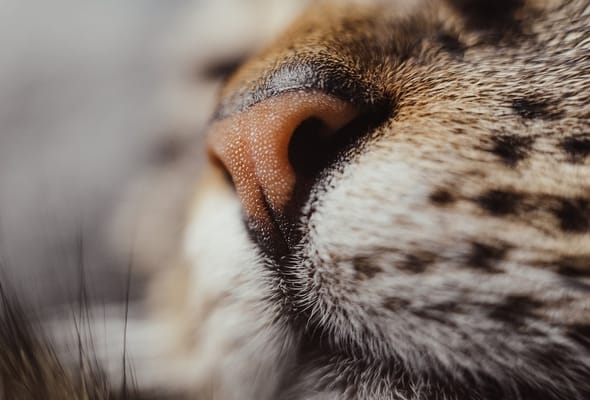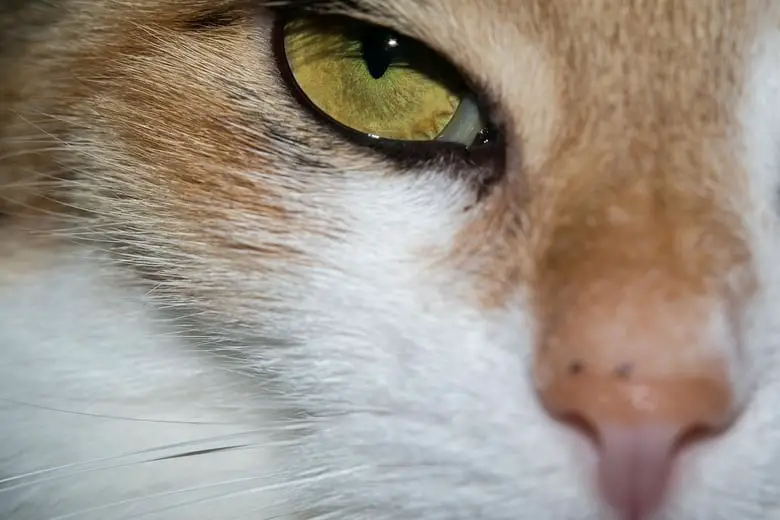Cat’s have an excellent sense of smell that is far stronger than our own. As predatory animals, cats are built to hunt and are equipped with the tools to help them locate and ambush their prey. With sharp ears, keen vision, an excellent sense of smell, and padded feet, cats are silent killers on the prowl.
While less stealthy, dogs are also known for their extraordinary sense of smell. Are the two comparable? Can cats smell better than dogs?
Can Cats Smell Better Than Dogs?
It depends. Cats are thought to have a keener sense of smell, which means they may be able to distinguish between similar scents better than dogs can. However, dogs’ noses can pick up on fainter scents, and can sense animals from a greater distance.
Because of this, it’s difficult to say which species has a better sense of smell. The answer appears to be circumstantial, and it may be more appropriate to ask which species is better equipped to use their nose in certain circumstances or for different tasks. This makes our answer more complex and worth delving into.
To begin with, cats and dogs, while both predators, use their noses in different ways, and are therefore built differently. In terms of appearance alone, there are obvious differences between the two that are immediately apparent to most people. Dogs have large, pointed noses, whereas cats have small, triangular noses that lay flat on the animal’s face.
Given the prominence of a dog’s nose, it makes sense why we would assume that they are equipped with a better sense of smell. In a way, they are, and there is a reason dogs are used over cats for search and rescue missions. However, beyond their sense of smell, dogs are more physically capable than cats, and their usefulness in work environments may also be due to their stamina and size.
In this article we’ll go over the physiological differences between a cat’s and a dog’s nose, as well as how they use their noses for different purposes. We’ll also discuss how and when one is better than the other, and vice versa.
What Does a Cat Use Its Nose For?
As we alluded to above, cats use their noses for a number of purposes. By learning what a cat uses its nose for, we can begin to understand how it works and why. To start, we already acknowledged that cats use their noses to help root out and track down small prey.

More than just recognizing if another animal is in the vicinity, they use their noses to distinguish what exact species of animal may be lurking around the corner. Knowing how to differentiate between the scent of a predator and that of prey can be the difference between eating lunch and being lunch, and it is essential to be able to distinguish between the two.
Beyond finding prey and escaping danger, a cat’s nose is essential to feline communication. While the nose itself does not communicate, it is used to pick up on the scents of other cats in the area. Cats use urine and scent marking to signal territory, find mates, and generally advertise their presence. By being able to pick up on these signals, these animals can distinguish and interpret the signs left by other cats.
Since humans have a relatively ineffective sense of smell, it’s hard for us to imagine just how useful noses are to cats. In many ways, a cat’s nose functions as another set of eyes, helping the brain to map out the inhabitants and objects in a given area.
How Does a Cat’s Nose Work?
Although much more sensitive than our own, cats’ noses possess many of the same types of receptors we have in our noses. Like us, their noses contain olfactory receptors that pick up and react to compounds in the air, translating these particles into practical information. Compared to our own 400 scent receptors, cats typically possess a whopping 50 to 200 million scent receptors.

Notably, cats can also interpret scents through two different organs. Of course, we all know about the nose they have in the middle of their face. However, you may not know about the vomeronasal organ located in the roof of a cat’s mouth. This sensory organ is keyed into pheromonal signatures left by other cats.
A cat’s nose is wet for a reason. The extra moisture on the surface of the face helps particles to stick and adhere to the skin, allowing the nose to pick up on even the faintest of scent trails.
Much like the added moisture, a cat’s whiskers also help pick up scents, essentially increasing the surface area of a cat’s face, casting a wide net that catches and draws in floating particulates.
What Does a Dog Use its Nose For?
Like cats, dog’s are predators that use their sense of smell to track and hunt down prey. However, unlike cats, dogs (or wolves) are built to hunt in packs, working as a team to locate and take down their next meal and stay out of danger.
Dogs also happen to use their sense of smell to communicate. As you likely already know, dogs will frequently sniff each other’s behinds as a friendly or romantic gesture, familiarizing themselves with their neighbor’s scent.
Although strange to us, this behavior is considered to be the equivalent of a human handshake. Dogs will use this heightened sense of smell to determine if a potential partner is in estrus and is biologically ready and mature enough to procreate.
Dogs are incredibly diverse in their appearance and genetics, and breeds have been developed for a variety of purposes. For this reason, a dog’s sense of smell will largely depend on its breed, with scent hounds being the top sniffers.
How Does a Dog’s Nose Work?
Larger and more physically capable than cats, dogs travel for long distances in pursuit of food or a mate. By comparison, cats typically maneuver in localized areas and through tight spaces. Their differences in hunting styles contribute to the different shape and functionality of their noses.
Putting aside flat-faced breeds like Pugs and Bulldogs, most dogs have long, pointed noses with wide nostrils. Larger nostrils and a longer nose means greater airflow into the lungs. As active and athletic animals, this is necessary to help them keep up their stamina on the hunt.
Moreover, a higher air intake means that dogs can filter through greater quantities of air for trace particles. Since their noses have a large surface area, they pick up any and all scents carried on the wind.
The moisture on a dog’s nose helps catch and retain scent particles, allowing the receptors to track and translate this sensory data into useful information. Compared to cats, a dog’s nose can contain up to 300 million scent receptors, making them sniffing powerhouses.
Conclusion
Because of their physiological differences and different hunting habits, cats’ and dogs’ noses are difficult to compare, and there is no clear winner. In terms of long-distance hunting and tracking, a dog’s nose is better suited to the job, as it can filter through large volumes of air quickly.
On the other hand, a cat’s nose may be better in close quarters, being capable of distinguishing between a wider range of scents.
Ultimately, a cat and dog’s sense of smell will also depend largely on their breed. While Bloodhounds may reign supreme over cats, your average tabby has the advantage over a flat-faced Pug whose sense of smell is inhibited by its smushed features.

